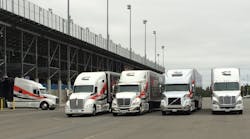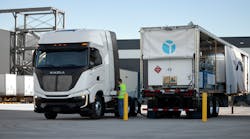For drivers operating new or post-2013 tractor trailers, the driving experience is considerably different from products produced in prior U.S. EPA regulation cycles that focused on the reduction of NOx and particulate matter. With the current emphasis on reducing greenhouse gas (GHG), specifically looking at CO2, optimizing the efficiency of the engine provides benefits to customer in the terms of fuel economy and GHG reduction.
Which powertrain improvements are contributing to the reduction of GHG and new driving experiences? Since 2013, the trucking industry and engine manufacturers have focused on the following ways to improve vehicle efficiency:
- Downspeeding to leverage the diesel engine’s low-end torque.
- Enhancing engine and transmission control interaction and increasing the adoption of automated manual transmissions (AMTs).
- Developing electronic features that assist in vehicle operation.
- Optimizing specs for specific duty cycles.
A Look at Downspeeding
Prior to 2013, most of the peak torque being produced in 12L to 15L diesels was occurring around 1,200 to 1,300 rpm. Today, peak torque can be produced as early as 1,000 rpm, as is the case for Cummins ISX15 engine.
With the traditional gearing approach of setting the truck to cruise 200 rpm above peak torque for a balance of fuel economy and performance, this 200 rpm difference in peak torque from 2,010 to 2,013 rpm doesn’t seem like a lot. However, for every 100 rpm decrease at cruise, drivers and fleets can expect between a 1 and 1.5 percent fuel economy improvement due to a reduction in frictional and parasitic losses.
To maximize fuel economy, operating or spec’ing to operate between 1,150 to 1,250 rpm can provide 2 to 3 percent fuel economy gains. In addition, the driver also will notice engine noise reduction.
Enhanced Control Interaction
One of the best ways to take advantage of the improved low-end torque of today’s diesel products is by spec’ing an integrated solution like the Cummins-Eaton SmartAdvantage powertrain or selecting an AMT.
As described, downspeeding provides the benefits for operating at lower rpms, but for fleets that want to consistently maximize these benefits, keeping the engine cruise speed closer to peak torque with automated shifting will enhance the fuel economy returns and reduce the overall wear and tear on the engine.
Operating closer to peak torque can result in an increase in the number of shifts per trip when using a traditional manual transmission, which can lead to increased driver fatigue and dissatisfaction. However, spec’ing an AMT powertrain reduces driver fatigue and improves the overall ease of operation.
Additionally with integrated powertrains, the engine and transmission share critical operation data, which allows for improved decision making. This shared information can provide for a smoother drive, enabled by torque modulation through shift events, and improve fuel economy.
Electronic Engine Features
Another way to improve vehicle efficiency is by enabling or disabling electronic features through the use of software (hardware for ECM communications is required). As a recent North American Council for Freight Efficiency report stated, this is an easy way to optimize driver performance and improve fuel economy.
By way of example, software such as Cummins PowerSpec allows adjustment of electronic features such as Load Base Speed Control, Gear-Down Protection and Vehicle Acceleration Management – a range from limiting speed to moderating acceleration rates in lightly loaded or bobtail conditions, which reduce cab rock as well as driveline and tire wear.
There are also features available that provide further improvement in fuel economy, vehicle operation and driveline protection, including torque modulation (based on operating conditions), coast at idle during downhill conditions (SmartCoast) and idle limiting features.
Optimized Duty Cycle Specs
Availability of peak toque at low rpms, along with the adoption of automated manual and automatic transmissions and electronic engine features, are all helping to improve fuel economy. But without the correct spec, the results from these improvements may not meet the desired expectations.
One consideration is that OEMs have developed specific hardware combinations that are optimized for specific duty cycles. For instance, Cummins has optimized the 400 to 475hp ratings for the ISX15 diesel for linehaul duty cycles, and transmission manufacturers like Eaton and Allison have developed specific shift schedules.
New axles are available, and owner operators of fleets that spend more than 85 percent of driving time in the top gear now have the option of spec’ing a downsped direct drive transmission with the availability of faster axles. This option allows truck owners to take advantage of both the inherent efficiencies of direct drive transmissions (1 to 2 percent fuel economy edge over overdrive transmissions due to reduced gear mesh) and the efficiency advantages seen with downspeeding.
This combination is successful in linehaul applications but may not be as beneficial when faced with a combination of long haul, regional haul, urban delivery routes and hilly topography.
Lower Total Cost of Ownership
When putting all of these improvements together, fuel economy should increase, maintenance intervals should be extended and the overall durability of the engine should improve.
When looking at oil drain, fuel filter, coolant and diesel particulate filter cleaning intervals, one of the key considerations when determining the maintenance schedule is the average fuel economy measured in miles per gallon. This provides an indicator of how hard the engine is working. As previously mentioned, new electronic features are available to help reduce driveline and tire wear and future features using look-ahead technology will help reduce sudden deceleration events, which helps prevent premature wear of service brakes.
Since 2013, the new tractors currently on the road operate at lower engine speeds, produce less noise, provide better fuel economy and have lower maintenance cost for the right applications.
Phase I of the GHG regulations provided a good foundation, which Phase II will continue to build upon. While the details of Phase II have yet to be finalized, we can expect to see further equipment improvements for the benefit of fleet owners, drivers and society as whole.
Mario Sanchez-Lara is the director of marketing communications and technical sales for the on-highway engine business at Cummins (www.cummins.com). The company is a global power leader that designs, manufactures, sells and services diesel engines and related technology around the world.



